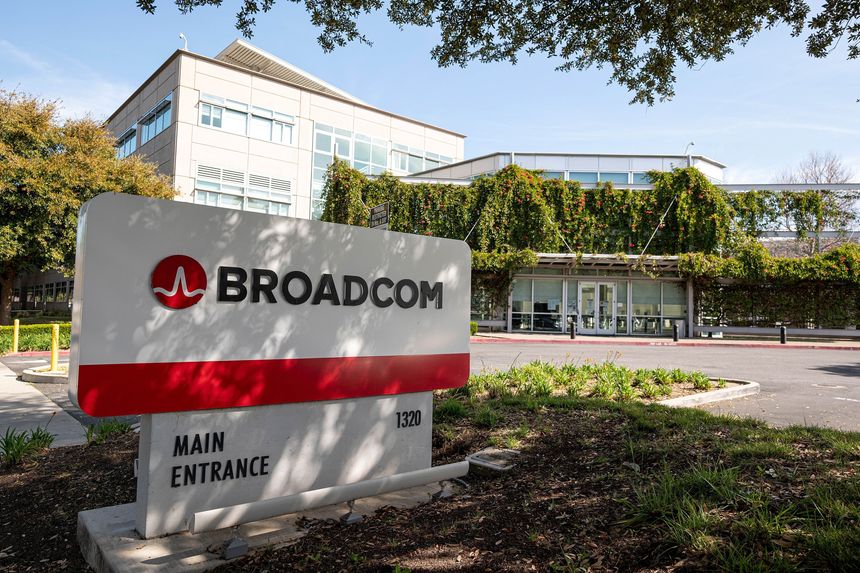
Broadcom’s stock has recently jumped, giving it a gain of 57% this year compared with the peer index’s rise of 41%.
Photo: David Paul Morris/Bloomberg News
It took a while, but the market finally seems to have come back around on Broadcom.
The chip maker—the fifth largest by annual revenue—has missed out on much of the rally that has propelled the market values of many of its peers over the past few years. Broadcom lagged the PHLX Semiconductor Index’s gains by nearly 13 percentage points in 2020 and 36 points the year before, and was running behind for most of this year up to the company’s fiscal fourth-quarter report earlier this month. The stock has since jumped 14%, giving Broadcom a gain of 57% this year compared with the peer index’s rise of 41%.
Why the change of heart? The latest report included a revenue forecast for the current quarter that was 5% ahead of Wall Street’s projections—cooling fears of a sharp seasonal drop-off in sales of smartphones that use the company’s chips. Broadcom also boosted its quarterly dividend by 14% and unveiled a $10 billion buyback. Both those moves were in keeping with the company’s prior commitments to return more cash to shareholders if it doesn’t find a major acquisition to pursue.
Deals were once Broadcom’s lifeblood. But it has been a little over two years since the company closed its last major one—the $10.7 billion pickup of Symantec’s enterprise security business. An unsuccessful run at closely held SAS Institute earlier this year ended up underscoring the challenges Broadcom will have in finding software assets compatible with its business philosophy; SAS employees reportedly protested the proposed deal for fear of losing their perk-heavy culture under the management of a chip maker known for running lean.
Broadcom has since chosen to own that image. At an analyst meeting in early November, the company spelled out the long-term goals for its software business that is now generating just a little over $7 billion in annual revenue. Broadcom said it expects the business to maintain annual growth over 5% and operating margins over 70%, mostly by focusing on cross-selling and up-selling to a base of about 600 core business customers. This strategy is expected to eventually lead to sales and marketing costs for software landing in the range of 6% to 7% of revenue, the company said.
That is in line with how Broadcom runs its chip side, but it would be anathema to most software companies that tend to expend huge sums to pursue growth and land clients. Sales, general and administrative expenses average 30% of trailing 12-month revenue for companies in the S&P 500 Software and Services Group—and 60% for the smaller, fast-growing cloud software companies in the BVP Nasdaq Emerging Cloud Index, according to data from S&P Global Market Intelligence.
But Broadcom has long focused on maximizing cash flows rather than chasing growth for its own sake. “If you’re willing to settle for 5% growth, you can make these assets hugely profitable,” Bernstein analyst Stacy Rasgon quoted Broadcom Chief Executive Hock Tan as saying at a recent client meeting hosted by the broker.
Mr. Rasgon estimates Broadcom can still manage to do a “moderate, mid-sized” deal even with its new buyback and raised dividend. But software valuations are still high; the S&P 500 Software group now averages more than 30 times forward earnings—its highest multiple in nearly two decades. And finding targets that will square with the company’s newly outlined approach will be harder still. But investors are showing that a Broadcom without big deals is still appealing, as long as the chip maker keeps playing to its strengths.
Write to Dan Gallagher at [email protected]
Copyright ©2021 Dow Jones & Company, Inc. All Rights Reserved. 87990cbe856818d5eddac44c7b1cdeb8
Appeared in the December 28, 2021, print edition.








